As a general of Shu Han, Guan Yu may not be the most dazzling in the Three Kingdoms era, where heroes emerged and stars were brilliant, but after his death, he was constantly interpreted and deified by people, from humans to holy, from saints to gods, becoming a god who worshipped from emperors, generals and ministers to ordinary people, black and white disciples, and people of the three religions and ninth ranks.
In the Central Plains, Guan Gong, as a typical representative of the culture of loyalty and righteousness, was highly respected and commended by rulers of all dynasties and was granted titles continuously. Buddhism also created the legend of Guan Gong’s death, Yuquan Mountain in Jingzhou after his death, and was guided by Master Zhizhe of Tiantai Sect and converted to Buddhism, making Guan Gong the legend of Kalan Bodhisattva, one of the two major guardians of Buddhism. Taoism followed closely Komiks and woven Guan Gong by Zhang Tianshi to subdue the Chiyou God who harmed the Yanchi Lake in Jiezhou, Hedong, and became the myth of the guardian god of the Yanchi Lake. Guan Gong was portrayed as the “Three Realms of Demon-Subduing Emperor”. Driven by various social forces, especially with the help of popular literary and artistic media such as Guan Gong Opera and Romance of the Three Kingdoms, Guan Gong’s image of loyalty, righteousness and bravery has become more deeply rooted in people’s hearts. Guan Gong is not only the object of Confucianism, Taoism and Buddhism, but also the god of war believed in by the army, the god of wealth revered by merchants, and the protector of industry worshipped by practitioners who make a living by slaughtering, haircuts, wooden work, knife and scissor shops.
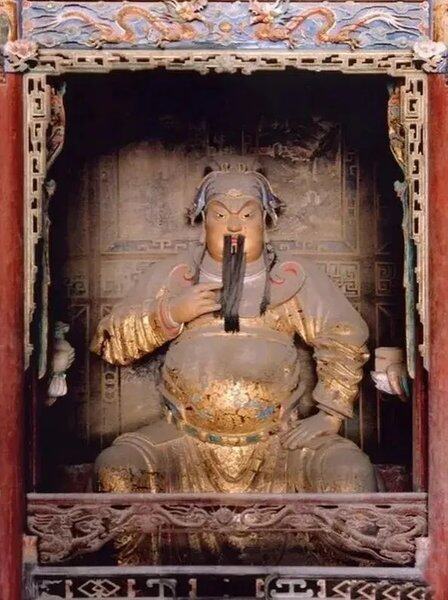
The statue of Guan Gong in the Guandi Temple in Jiezhou.
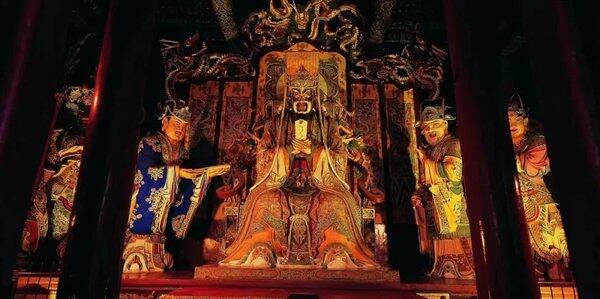
The statue of Guandi in Guanlin, Luoyang.
Among all these divine bodies, the God of War and the God of Wealth are the most well-known. Because Guan Gong fought bravely during his lifetime, at the latest in the Middle Tang Dynasty, Guan Gong was already regarded by the people as a god of war to protect the place in Jingzhou when he died. During the Song and Yuan dynasties, it became even more popular for the army to visit Guan Gong Temple before the battle, and praying for Guan Gong to appear and help the battle. But at the national sacrifice level, Guan Gong warThe status of God was established relatively late. In the Wucheng King Temple, which existed briefly during the reign of Emperor Dezong of Tang, Guan Gong was one of the 64 famous generals of all dynasties and worshipped King Jiang Ziya, but he was only ranked 15th on the left. Since then, from the reign of Emperor Renzong of the Northern Song Dynasty to the early Ming Dynasty, Guan Gong was only a famous general in the temple of King Wucheng. By the 20th year of Hongwu (1387), Zhu Yuanzhang abolished the Wucheng King Temple system that had been along for hundreds of years, resulting in a vacuum of war at the national level. However, driven by the army’s tradition of advocating the god of war, the Ming Dynasty had to establish a god of war. Therefore, Guan Gong, the god of war that has been widely circulated among the people for a long time, stood out. In the 27th year of Hongwu (1394), the Ming Dynasty built the Guanyu Temple in Jiming Mountain, Nanjing and included it in the national sacrificial ceremony. At this point, Guan Yu officially replaced Jiang Ziya and became the national god of war, and continuously expanded his social influence under the promotion of various forces between the government and the people.
As the God of Wealth, Guan Gong may have a great relationship with the activity of Shanxi merchants in the Ming and Qing dynasties. In order to encourage merchants to transport grain to the border, the Ming Dynasty implemented a Chinese-French system that exchanges grain for salt and gives merchants the qualification to sell salt. Because of the convenience of getting close to the northern border, Shanxi merchants gradually developed into one of the best business groups in the country. The Shanxi merchants’ guild halls have also spread all over the country with the expansion of their business territory. In the guild hall, Shanxi merchants usually worship Guan Gong, a god from Shanxi, in order to connect with the countryside and ensure a prosperous business, making Guan Gong accepted by people as the God of Wealth. In addition, in the traditional society that emphasizes the distinction between justice and profit, Guan Gong’s image of trustworthiness and righteousness is neglecting wealth, valuing promises and keeping promises and repaying kindness will also help alleviate the inner tension caused by businessmen chasing wealth.
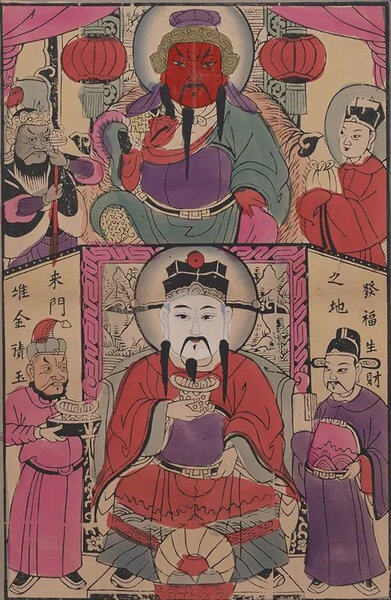
The Qing Dynasty painting “Shangguan Xiacai”. The New Year paintings are Guan Gong on the top and the God of Wealth below, which means official and wealth.
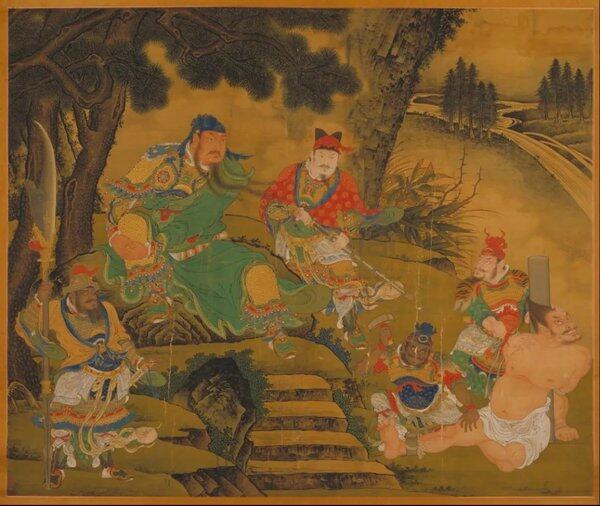
Ming Shang Xi’s “Guan Yu Captures Generals”.
InterestingCinema The worship of Guan Gong is not limited to the Central Plains. In the vast border ethnic areas, Guan Gong is also an important god widely worshipped by local people.
The legend of Manchu peopleBabaylan
Long before the Manchus entered the pass, the story of Guan Gong had been introduced to the Northeast along with popular literature and art such as “Romance of the Three Kingdoms”. The personality charm shown by Guan Gong in the novel can easily make Manchus who are good at riding and shooting and advocating bravery psychologically close. The upper rulers are in order to strengthen their rule and win over the Han Dynasty. href=”https://funnybookish.com/”>Babaylan, Mongolian, North Korea and other people strongly advocate Guan Gong, who is brave and loyal. It is said that when Nurhaci fought with the Ming army, he received Guan Gong’s face-to-face advice from Guan Gong in his dream to help him escape. For this reason, he specially built the Guandi Temple in the west of Hetuara City. Huang Taiji included Guan Gong as the ritual sacrifice of the shamanism in the early morning of the day. This practice later came to an end. The palace life in the Qing Dynasty was continued, and Guan Gong was an important god for the Kunning Palace Festival. The Qing Dynasty rulers respected Guan Gong as the guardian god of the Qing army. Before going to war, they would worship Guan Emperor Temple to pray to Guan Emperor to bless them to conquer the city and conquer the land and win a thousand miles. The praise of the upper rulers made ordinary Manchus worship Guan Gong, and many ordinary people even named their children with the word “Guan” to seek the protection of Guan Gong. The Guarjia family, one of the eight major surnames of the Manchus, is mostly transliterated as Guan surname, which may also be related to CinemaGuan Gong worships.
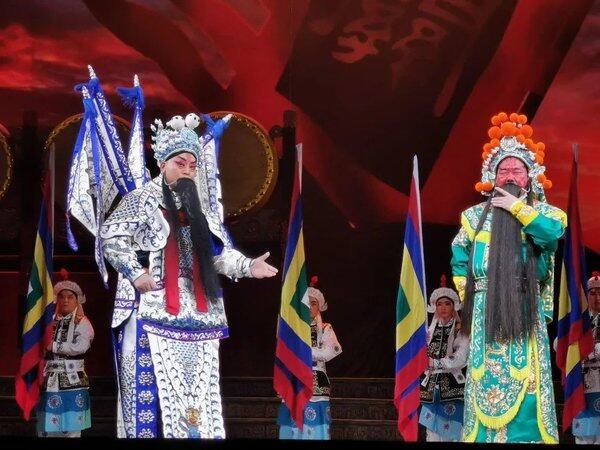
Stills from Henan Opera “Yibo Yuntian”.
Manchus also called Guan Gong “Guan Mafa”, “MaCinemaFather” is the Manchu “yes” and “ancestor”. For a long time, many legends about Guanmafa have been circulated among the Manchu people, one of which is called “Guanmafa Uleben”, which is told in Manchu language.The legendary life of “Guanmafa”: He was reincarnated by Caolong and saved by the Goddess Mother. Later, he was killed by pursuers. The Goddess Mother asked him to wash his face by the river, so he became a red-faced child. He is extremely powerful and skilled in archery. When he grows up, he competes with the god Chao Hazhanye of Changbai Mountain, fights with the evil god Yaleli, and Cinema to save the suffering Jurchens in the north. The whole story is performed by the narrator in a combination of speaking, singing and reciting. It usually takes more than ten nights to finish.
After the Manchus won the Central Plains, they vigorously promoted Guan Gong’s loyalty, righteousness and courage, and regarded Guan Gong as the protector of the Qing Dynasty. The Qing court awarded Guan Gong 13 times, and Guan Gong was upgraded from the “Han Shouting Marquis” during his lifetime to the “Loyalty and righteous God Wu Ling blesses and bravely shows his power to protect the country and protect the people, sincerely applauding Emperor Xuande Guan Sheng”, making Guan Gong truly a perfect god who has no blind spots and comprehensively protected the country and the people. In addition, the Qing court also required localities to establish temples dedicated to Guan Gong, and instill the concept of loyalty to the emperor and serving the country into the people, which led to the Qing Dynasty the situation of “Guan Gong’s temples all over the world”. Some people have counted that in the middle of the Qing Dynasty, there were more than 300,000 Guandi temples across the country, even more than the Confucius Temples. As of today, Guandi Temple is still an important cultural landscape in many places.
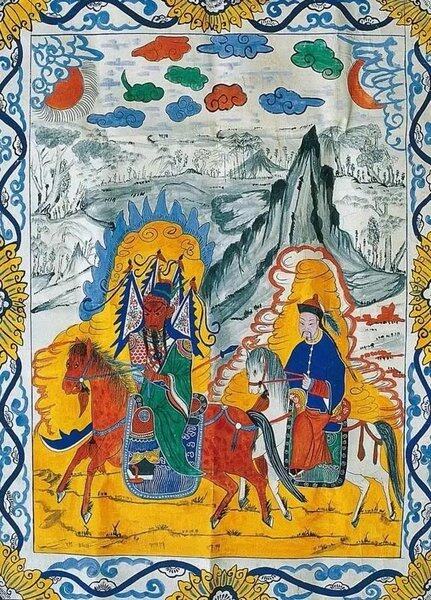
Guan Gong and Zu, who were worshipped by Manchu families, were first.
“Gesar” in the Pantheon of Tibetan Buddhism
Among the cliff carving statue group in Haitang Mountain in Fuxin Mongolian Autonomous County, Liaoning, there is a statue of “Master Riding Horse”: Guan Gong is wearing military uniform and riding on a Red Rabbit Horse. He held the reins in his left hand and the Qinglong Yanyue Sword in his right hand. There were five long beards on his chest, surrounded by auspicious clouds in front and back. What attracted scholars’ special attention was that a square Tibetan seal was engraved on the back of Guan Gong’s body, which was translated as “the seal of the Panchen Lama Erdeni”. On the dome outside the Buddha’s niche is engraved with a line of Tibetan text, translated as “Master Guan” in Chinese; there is a Mongolian couplet decorated with auspicious clouds and double-layer lotus petals at both ends on the left and right, translated as “Blessings are as abundant as the slender Sita River, and life span is as beautiful as the moon’s wish-full beads.” What kind of historical secrets are hidden behind the appearance of such obvious Mongolian and Tibetan cultural factors in Guan Gong’s statue located in the Northeast?

Picture of Master Jima Guan.
In fact, the Mongols had already come into contact with Guan Gong’s beliefs as early as the time of the alternation of the Jin and Yuan dynasties. Given the importance of Chiyan in Jiezhou to the national finances, they naturally continued the practice of worshipping Guan Gong’s god of salt in the Song and Jin dynasties. After the Mongolians entered China with their unprecedented martial arts and established the Yuan dynasty, Guan Gong, the brave and powerful god of war, must have a unique charm to them. According to historical records, the grand Buddhist ceremony “Traveling the Imperial City” held in the Yuan Dynasty palace, carrying the statue of Guan Gong’s god was an important part. Guan Wang Temple began to be widely established throughout the country. The people of the Yuan capital were influenced by the upper rulers and also held a grand Guan Wang Conference on the Dragon Boat Festival. In the late Ming Dynasty, they rose to the east The Qing rulers in the north compared their relationship with the upper Mongolian class to Liu Bei and Guan Yu. On the one hand, they won over each other with Guan Yu’s special status, and on the other hand, they used Guan Yu’s loyalty and righteous spirit to conquer Mongolia. In the Qing Dynasty, with the mainland’s garrison, Mongolian merchants, and reclamation people, they came to the Mongolian area with their families and their children. Temples worshiping the God of War and the God of Wealth Guan Gong also appeared more and more on the Mongolian Plateau, and Guan Emperor Temples were built in towns such as Guihua City, Chaktu, Ulyasutai. From this, it can be seen that it is not surprising that Mongolian couplets appeared in the statue of Master Qima Guan.
As for the appearance of Tibetan language in the statue, it is related to Tibetan Buddhism’s absorption of the God of War Guan Gong and the Mongolians’ conversion to Tibetan Buddhism.
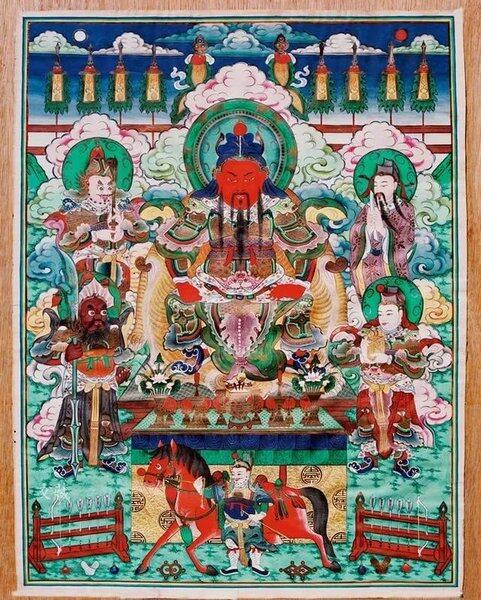
Yonghe Palace has the Qing Dynasty Guan Gong Thangka.
In the Yuan Dynasty, the image of the god of war Guan Gong had been introduced to Tibetan Buddhism. Since the late Ming Dynasty, with the strengthening of personnel exchanges and economic and cultural exchanges between the mainland and Tibetan areas, some Guandi temples were established in various Tibetan areas where Tibetan Buddhism culture dominated. Especially after the early Qing Dynasty sent troops to pacify local turmoil in Tibet and Qinghai, local officers and soldiers also brought their devout faith in Guan Emperor. For the god Guan Gong from the Han area, the Zhangjia Living Buddha, Tuguan Living Buddha, and the Sixth-generation Banchen of Tibetan Buddhism The monks of the living Buddha did not turn him out, but instead, in order to strengthen the connection between the Tibetan area and the central government and maintain the friendship and unity between the Tibetan and Manchu and Han ethnic groups, they wrote a prayer to introduce Guan Gong in detail and rituals, and included Guan Gong in the ranks of the guardian gods of Tibetan Buddhism. In the prayer to the sacrifice, Zhangjia Living Buddha also appeared and told the story of Guan Gong helping him escape the disaster on his way to Beijing by entrusting his dreams and promising to protect Buddhism. The image of Guan Gong’s red face and beautiful beard is quite similar to the guardian god Chi Zunzan and the war god Gesar in Tibetan Buddhism, making Guan Gong easy to be popular.The Tibetan people are attached to the corresponding gods.
According to legend, in the 57th year of Qianlong (1792), Fukang’an and Hailancha led the Qing army to counterattack against Gurkha’s invasion of Tibet, the Qing army was caught in an ambush circle set by the enemy because they were unfamiliar with the terrain. The enemy relied on the danger of counterattacking. Although the Qing soldiers rushed bravely, they were still unable to break through the siege. Just when his morale was extremely low, he suddenly saw fires rising from the enemy formation, and shouts were shaking. Manchu and Han soldiers seemed to see countless Guan Gongs holding big swords to enter the enemy camp, and Tibetan soldiers seemed to see countless Kings of Gesar riding horses to kill the enemy. With the inspiration and assistance of the gods, the morale of the Qing army was greatly boosted, like a divine weapon descending from the sky, rushing towards the enemy formation, seizing the strategic high ground, and finally turning the situation around and achieving a great victory. After the triumphant victory, the soldiers were surprised to find that the god they vaguely saw in the battle was the Guandi worshipped in the Guandi Temple in Mopanshan that started construction before the expedition. From then on, Tibetans called this Guandi Temple “Gesalakon”, which is the Temple of Gesal. It can be seen that although the god of war Guan Gong and King Gesar are different in the eyes of believers, they are actually one.
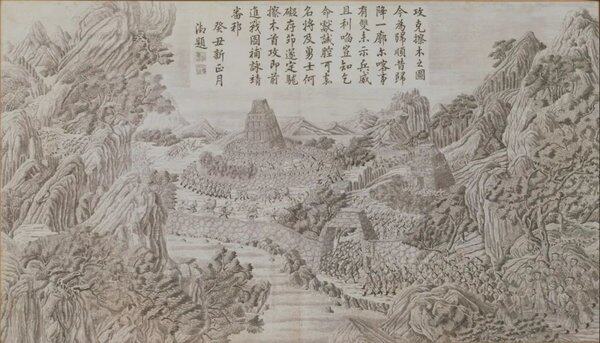
Put Gurkha victory map.
Guan Gong was thus connected to the pantheon of Tibetan Buddhism, becoming a god worshipped by all ethnic groups who have lived in the snowy plateau for generations, and then spread throughout the entire area of influence of Tibetan Buddhist culture. It is not difficult to understand that the Mongolians engraved Tibetan content when building the statue of Guan Gong in Haitangshan, Komiks, because of the influence of Tibetan Buddhism.
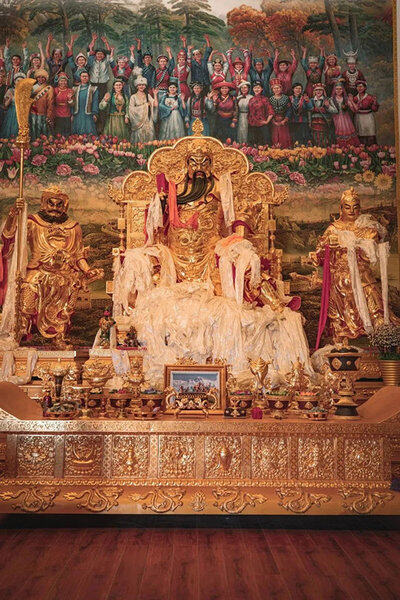
The Guandi statue in the Guandi Temple, the highest altitude of Everest, is in the world.
The “Martial Saint Arrow God” in the minds of the Xibe people
The Xibe people are a nation that has lived in the northeast for generations. They have accepted Guan Gong’s belief in cultural exchanges with the Han and Mongolians. The Xibe family temple Taiping Temple built during the Kangxi period is about the Guandi Temple. After the establishment of the land moved westward to Xinjiang, the Xibe people also brought their devout faith in Guan Gong. Every Niulu where the Xibe people are located has a temple dedicated to Guan Gong. The Xibe people are a nation that is good at archery and often hold archery competitions. Before the game, the archers will worship togetherThe Arrow God Guan Gong begs to be like Guan Gong to be brave and brave, and achieve success in the competition. Guan Gong is also a martial saint who is extremely respected by the Xibe people guarding the border. There is still a legend about the Xibe tribe. In the battle of Hunbashi River, the key battle of the Zhang rebellion in the sixth year of Daoguang (1826), 500 Xibe officers and soldiers fought fiercely with nearly 10,000 Zhang Geer rebels. Fortunately, Guan Gong descended from the sky to help, so he turned the situation around, defeated the more with less, and finally established the victory of the entire war. After the war, the officers and soldiers of Xibe Battalion cast a large bell, and the bell cast a portrait of the relevant male, and the bell was engraved with the inscription “Loyalty, righteousness, God, Martiality, Benevolence, and Spiritual BlessingsBabaylanThe Emperor of Gods”. If we look back at the legend that appeared when the army counterattacked the Gurkha invasion, we will find that Guan Gong has become an important symbol for all ethnic groups including the Han, Manchu, Tibetan, Xibe to resist foreign invasions, and to defend the territorial integrity of the motherland and maintain stability in the border areas.
In addition, there is a widespread belief in Guansuo in the southwest region. People used to think that Guansuo was Guan Gong’s third son. Recent research has found that Guansuo is actually a local variant of Guan Gong himself. Among the Miao, Bai, Qiang, Tu, Hezhe, Daur and other ethnic groups, there is also a unique worship of Guan Gong.

The Ming Dynasty clay sculptures painted Guan Gong statues.
The Qing Dynasty Zhao Yi once lamented the prosperity of Guan Gong’s beliefs: “Now, the Antarctic Ridge is on the surface of the North Pole, and all children and women will shock their power. The prosperity of incense will be immortal with the heaven and earth.” The unprecedented unified pattern of the Qing Dynasty created favorable conditions for personnel exchanges, economic exchanges, and cultural integration between the mainland and the border. With the joint promotion of official and civil forces, Guan Gong also introduced from the mainland to the border areas and entered the local temples and temples, becoming a god widely worshipped by all ethnic groups. In this process, legends about Guan Gong, rituals worshipping Guan Gong and even Guan Gong’s style may become more ethnic, but people of all ethnic groups deeply agree thatGuan Gong’s inner spirit of loyalty, righteousness and bravery regards Guan Gong as a cultural symbol of protecting the country and safeguarding the people and maintaining the borders in Yongjing. This is the most worthy of our exploration and cherishing today.
Author profile:
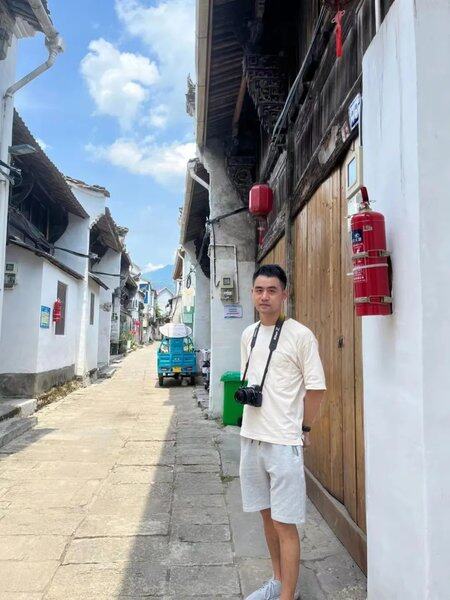
Zheng Junhua, a young teacher at the School of Ethnology and Sociology of Central South University for Nationalities, graduated from Fudan University with a Ph.D. in History, and is mainly engaged in the study of the history of the Chinese nation.